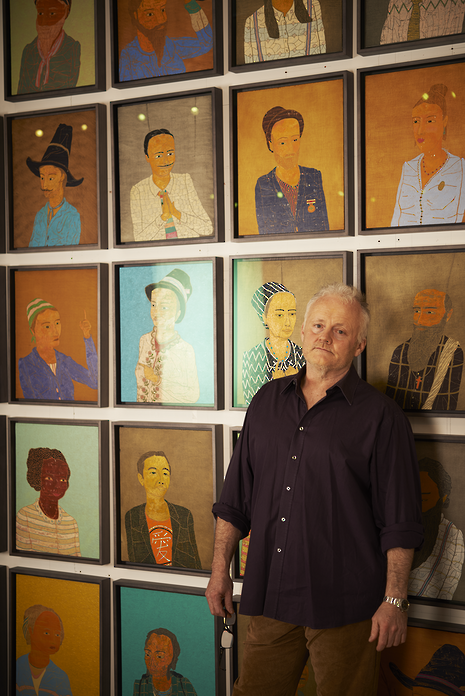Pirates, literary legends and heavy metal rock stars: Stephen Chambers’ Court of Redonda
Georgie Kemsley-Pein interview Stephen Chambers in the leadup to his exhibition at Downing’s Heong Gallery
As I greet Stephen Chambers in the Heong Gallery at Downing College, I am ushered into a court of caprice and imagination, artistic in-jokes and fictitious gesture. Confronting me is a series of one hundred and one painted portraits: alone and individual, the contingent depicted by the London artist is baffling in its stilted flatness and atemporality.
The Redonda legend is the brainchild of the work, a desolate outcrop of an island in the Eastern West Indies which is a cluster of rocks the size of Hyde park: “uninhabitable and almost unlandable”, Chambers explains.
The history of Redonda as a Kingdom begins in 1865, when a merchant trader asked Queen Victoria permission to claim Kingship over the island. This having been granted, a linearity of kings flowered, and the island was passed onto the trader’s son before poet John Gawsworth became king in 1947. From there, Gawsworth implemented a Redondan court, consisting of creative individuals as he offered knighthoods, dukedoms and positions of power to his friends. Spanish writer Javier Marías continued this tradition, and it is his court today on which Chambers has based his paintings; the artist has almost mechanically churned out these portraits over a period of 14 months, which were first exhibited at the Venice Biennale last year.
"Chambers doesn’t burden his series with overt politicism; the comic and the whimsical is at the centre of his art"
The Royal Academician was dazzled by Marías’ works during his time in Brooklyn. He explains to me that at points in his career he often embarks on “an itinerant life, where I go and rent studios around parts of the world”. His interludes of travel in a separate time zone (usually America or Mexico) give him distance to work, he says: “it’s like beginning again, I’m just left alone.”
But whilst Marías’ hand-picked Redondan court comprises of real people (Marías conferring titles on figures such as Wiliam Boyd and A.S. Byatt) Chambers has chosen to configure the physiognomy and personalities of the sitters entirely based from his imagination. The whole project is entirely conceived in the mind, and is fundamentally about the power of the imagination. As Chambers puts it in the catalogue for the Biennale exhibition, “The Court of Redonda is… bringing to the High Table those that would normally be fed in the garden shed.” He has conceived his utopian vision of a court of “artisans and creators and makers of things”.
That Chambers is offering to us “a court of people who would not otherwise be in a courtly situation” is political, too. In tandem with Brexit and its coeval struggles with diversity and tolerance, one can read a greater cultural relevance into the ethnographic types of Chambers’ individuals, and his work is based on “undercurrents of dissatisfaction and resentment about movements of peoples around the world.” I ask him what he wants the viewer to come away with after viewing his exhibition. Speculation, he says: “I want to give the beginnings of what might be, and then those to be concluded when I’m not here, and then everyone will get to a different point”.

But Chambers doesn’t burden his series with overt politicism; the comic and the whimsical is at the centre of his art, and the coloured etchings in the room bring to mind works like Goya’s Caprichos. The individual names of the court members are humorous too, and represent types – “everyman, everywoman” - from “Queen of Tickertape” and “Harold the Bum” to “Boris, el Seductor”. I ask him about one figure in particular, with long grey hair and an oddly shaped hat, which makes him chuckle. The individuals are “nearly always entirely imagined”, but here there was an inspiration. He asks me if I’ve heard of the heavy metal “psycho” Lemmy, and I reply I haven’t. Chambers remarks that he was never that interested in the music, but “thought he had quite a good look”. Standing in the midst of a fictive world of courtly creatives, then, stands a heavy metal superstar; Chambers is proving to be quite the master of oddity, eclecticism and surprise.
But on other matters of inspiration, Chambers seems disinclined to talk. Despite the similarities between his work and Indian Mughal painting, he denies any sort of influence, claiming he’s “very badly travelled East”, and has never actually been to India. The paintings use traditional methods, something which derives from his time as a student looking at the works of 15th century masters such as Sassetta. Comprised of panels of wood covered with gesso and then painted on in oil, the individual portraits are “set in Nethertime”, and his style can be explained by his preference for simplicity. “Often with what I do I’m trying to keep things as simple as possible”, he remarks, as he relies predominantly on line and brilliance of colour to animate his works, which retain a striking sense of two-dimensionality. He frequently slashes the surface to create a distressed aesthetic, as he likes injecting “a bit of discord or unpredictability” in his works, something which creates “static shock” and tension.
Whilst exquisitely painted and dazzling in their colour combinations, it seems the weight of Chambers’ Court of Redonda hinges on concepts and ideas. His paintings are about conversations and intimacy; Chambers’ own dialogue with Marías is reflected in our viewing of the characters which cover the walls of the Heong, people which he has fabricated from the vision of his mind. He creates his paintings on an almost subliminal level, allowing the autonomous nature of imagination to be the king of his art, as he explains his indiscernible style by the pithy and equally mysterious statement: “I do what I can’t help doing”
 Comment / Plastic pubs: the problem with Cambridge alehouses 5 January 2026
Comment / Plastic pubs: the problem with Cambridge alehouses 5 January 2026 News / New movement ‘Cambridge is Chopped’ launched to fight against hate crime7 January 2026
News / New movement ‘Cambridge is Chopped’ launched to fight against hate crime7 January 2026 News / Uni-linked firms rank among Cambridgeshire’s largest7 January 2026
News / Uni-linked firms rank among Cambridgeshire’s largest7 January 2026 News / Cambridge businesses concerned infrastructure delays will hurt growth5 January 2026
News / Cambridge businesses concerned infrastructure delays will hurt growth5 January 2026 Features / Who gets to speak at the Cambridge Union?6 January 2026
Features / Who gets to speak at the Cambridge Union?6 January 2026










